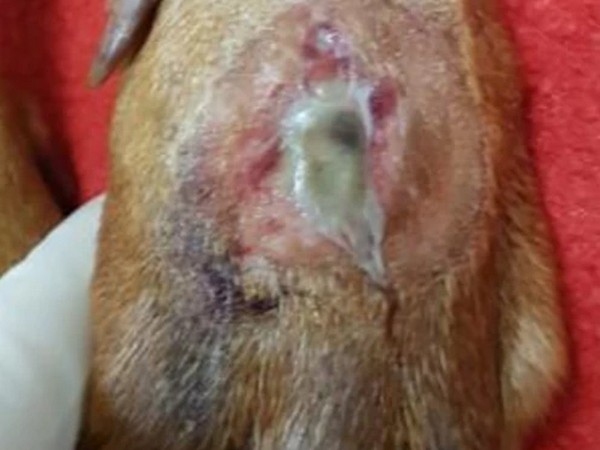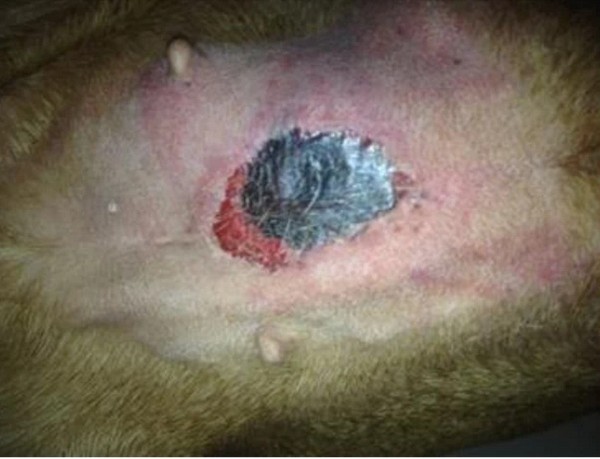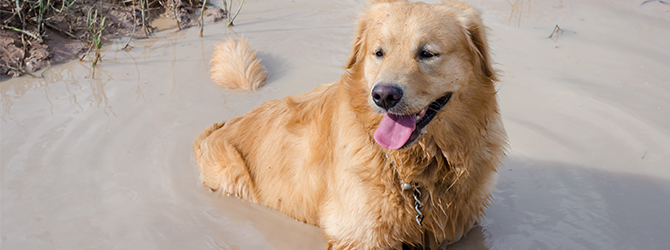Alabama Rot in dogs: what is it and how to prevent it
Alabama Rot, also known as Cutaneous and Renal Glomerular Vasculopathy, or CRGV, is a mysterious disease affecting dogs in the UK. While rare, cases do occur and are often fatal, making it an ongoing concern for dog owners.
In this article, we'll explore what it is, symptoms to watch out for, and what to do if you think your dog might be affected. We'll also discuss the latest research and advice from vets on protecting your dog from this disease.
What is Alabama Rot?
Alabama Rot is a serious condition, characterised by blood vessel damage that leads to skin lesions and sometimes kidney failure. It can affect dogs of any age, size and breed. The initial skin ulcers can progress quickly, often within days, to acute kidney injury, which can be severe, resulting in less or no pee. The condition was first reported in the US in the 1980s, after being found in Greyhounds at racetracks in Alabama, hence the name.
What causes Alabama Rot?
The short answer is we don't know what causes this disease. Researchers have been trying to figure this out, but there's still no clear answer.
Some theories suggest it might be linked to bacteria or toxins, but nothing's been proven. Others think it could be related to the dog's environment, as walking in muddy or wooded areas appear to be potential risk factors, but again, there's no solid evidence for this.
The best thing you can do is be aware of the symptoms and act quickly if you notice anything wrong.
Is my dog at risk of Alabama Rot in the UK?
Unfortunately, the disease has been reported in the UK, so there is a risk. However, it's worth noting that the number of cases is relatively low compared to other dog health concerns - there have only been 277 confirmed cases across the UK between November 2012 and July 2021. Cases in the UK have been spread out across more than 30 counties, and they are more common between November and May. Among the dogs examined in this study, crossbreeds made up 21% and Labradors 16.8%. Over half, 53.9%, were female, and 66.3% had been neutered.
Some studies have suggested certain breeds like Flat Coat Retrievers, Hungarian Vizslas, Whippets, and English Springer Spaniels may be more prone to the disease. There have also been reports that walking your dog in muddy, woodland areas can increase the risk, although these links remain unconfirmed.
Read more: All you need to know about seasonal canine illness
Alabama Rot symptoms
Initial symptoms of Alabama Rot might not look serious, but if you spot any of the following contact your vet as soon as possible. Here's what you should look out for:
Skin sores or lesions

Credit: Gregory Cameron MVB, AllPets Drogheda
The first sign is usually a sore or lesion that appears for no clear reason. These are often found on the lower legs or paws, but also on the body and face. They might look like a patch of red skin, or they could be open sores.

Credit: Gregory Cameron MVB, AllPets Drogheda
Kidney failure
The disease can quickly lead to acute kidney injury, which may cause reduced urine production (known as oliguria) or no urine at all (known as anuria). On average, studies show it usually takes three days from when skin sores show up to kidney failure setting in, but this can be anywhere from four to 45 days.
The signs of kidney failure include:
- Lethargy - your dog might seem more tired than usual or less interested in going for walks or playing.
- Loss of appetite
- Vomiting
- Drinking more - changes to thirst and urination habits are common with kidney disease
TMA
Alabama Rot is also known to trigger a specific type of damage to blood vessels called thrombotic microangiopathy (TMA). This damage can lead to tiny blood clots forming, disrupting the flow of blood to vital organs. In some cases, this may lead to neurological issues such as seizures, as the blood vessels in the brain can be affected.
Jaundice and anaemia
Other signs of Alabama Rot can include jaundice, anaemia, and low platelet counts (thrombocytopenia). This may be seen as your dog’s gums being very pale, or having a yellow tinge.
If your dog shows any of these signs, especially skin sores, get them to the vet as soon as possible. Your vet will likely run tests and might refer you to a specialist for more treatment. The sooner you catch it, the better the chances are for your dog.
Alabama Rot treatment
Treatment will always depend on the severity of the condition and your dog's health, but will generally follow these steps.
Diagnosis
Your vet will likely start with a physical examination and may take skin and blood samples. These tests are to confirm the disease and rule out other conditions that might look similar. Remember, Alabama Rot is rare, and so it is often more likely that some other health problem is causing your dog’s symptoms, and this is crucial to investigate.
Supportive care
There's no specific cure, so treatment usually focuses on supportive care. This might include fluids to help with dehydration and to support kidney function, pain relief for skin lesions, medication for anaemia, and addressing any other complications that arise. Large skin lesions may need more intensive treatment, such as cleaning and debriding under sedation, or swabs taken to check for infection.
Kidney support
If the disease has affected the kidneys, more intensive treatment, like dialysis, might be needed. This is usually done at a specialist clinic.
Plasma exchange therapy
This is a process where plasma, the liquid part of the blood, is removed and replaced with fresh plasma or a plasma substitute. It has been suggested as a treatment option and may improve the chances of survival. This treatment filters the dog's blood to remove toxic substances, including whatever is believed to be causing the disease. This cleaned blood is then transfused back into the dog.
In this study, published in Frontiers in Veterinary Science, six dogs were treated with this method, and two fully recovered.
Monitoring
The vet will monitor your dog closely to see how they respond to treatment. This will likely involve regular blood tests and possibly other diagnostic tests.
Prognosis
It's really tough to say what the outcome will be, as it varies from dog to dog. Some dogs do recover with prompt and appropriate treatment, but sadly, Alabama Rot can be fatal, especially if it leads to kidney failure.

How to prevent Alabama Rot
Preventing this disease is difficult because we don't know exactly what causes it. But there are some precautions you can take to try and keep your dog safe.
Wash them after muddy walks
Some people recommend washing your dog's paws and legs after walks, especially if you've been in muddy or wooded areas. This isn't proven to prevent the disease, but it may help you detect skin lesions on your dog.
Avoid certain areas
If there have been reported cases in your area, avoid walking your dog there. Some websites and vets keep track of where cases have been reported.
Check for symptoms
Keep an eye on your dog for any signs of the disease, like skin sores, especially on the legs, paws, or belly. The sooner you spot it, the better.
Regular vet check-ups
Regular visits to the vet for general health checks can help catch any issues early, not just serious illnesses.
Stay informed
Keep up to date with the latest information on this disease. The more you know, the better you can protect your dog.
What’s the mortality rate of Alabama Rot in dogs?
The mortality rate is estimated to be above 90%. That means at least nine out of 10 dogs who get the disease do not survive, even with treatment.
The outlook is particularly poor for dogs who develop severe kidney issues and a decrease in urine production. The prognosis is better for dogs who present with skin lesions but no effects to the kidneys.
This is why it's so important to get your dog to the vet as soon as you notice any symptoms. Early diagnosis and intensive care are the best chance your dog has for surviving this disease.
Can humans get Alabama Rot?
There's no evidence to suggest that humans can catch Alabama Rot from dogs. It seems to be a disease that only affects dogs.
Is Alabama Rot contagious between dogs?
As far as we know, Alabama Rot is not contagious. There's no evidence to suggest that it spreads from one dog to another. So, if you have more than one dog and one of them shows symptoms, it doesn't necessarily mean your other dog will catch it.
However, because the exact cause is still unknown, it's always a good idea to be cautious. If one of your dogs is diagnosed with it, follow all the advice and treatment plans your vet gives you.
When should you visit your vet about Alabama Rot?
This disease can progress quickly and can lead to serious issues like kidney failure, which is often fatal.
So, if something seems wrong, don't wait. Take your dog to the vet as soon as you can for a check-up. Your vet will likely run some tests and might even refer you to a specialist for more treatment. Early diagnosis and treatment are really important for dealing with this disease.
Any studies into Alabama Rot?
In 2017, a team dedicated to tackling the disease was set up, featuring experts from the Royal Veterinary College. They're working hard to get to the bottom of what causes this condition and how it spreads.
Scientists at the University of Bristol also believe they may be close to discovering what causes the disease. The researchers have identified a potential bacterial cause and are asking vets to send samples from dogs suspected of the disease.
Anderson Moores Veterinary Specialists has been leading the research since 2013. They've been collecting detailed questionnaires from owners of confirmed cases to aid in research. Around 300 dogs from 38 counties in the UK have been diagnosed with CRGV since November 2012, and the disease is currently only definitively diagnosed post-mortem.

Need more info?
For more information on Alabama Rot in dogs, contact your local vet.
Find your nearest vet using our Find a Vet page, or speak to a vet online using Online Vets.


